


|
 |
|
|
#1 |
|
Registered Member
Join Date: Sep 2010
Location: India
Posts: 52
|
Seahorse ID
Hello everyone,
I have recently got some seahorses as a gift from my friend. 20 beautiful ponies. But I am not very well versed with the seahorses. I have made them a custom tank 18" X 18" X 21" (26g) with 7.5g fuge. Water Parameters are as below. nitrates - 0 -5 ppm phosphates - 0/not detected ammonia - 0/not detected calcium - 420 Dkh - 7 - 7.5 Normal temperature - 77/78 F Here's the problem, these are very delicate and petite creatures, and with my limited knowlegde i am not able to ID them. I would really appreciate some help IDing these horses. 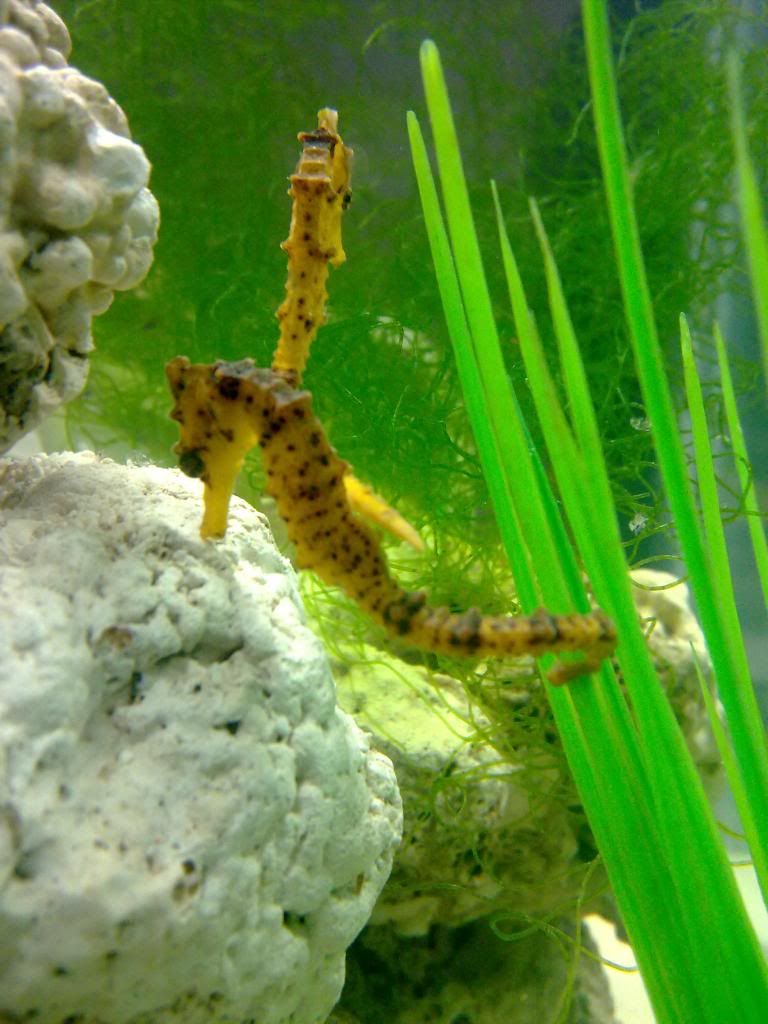 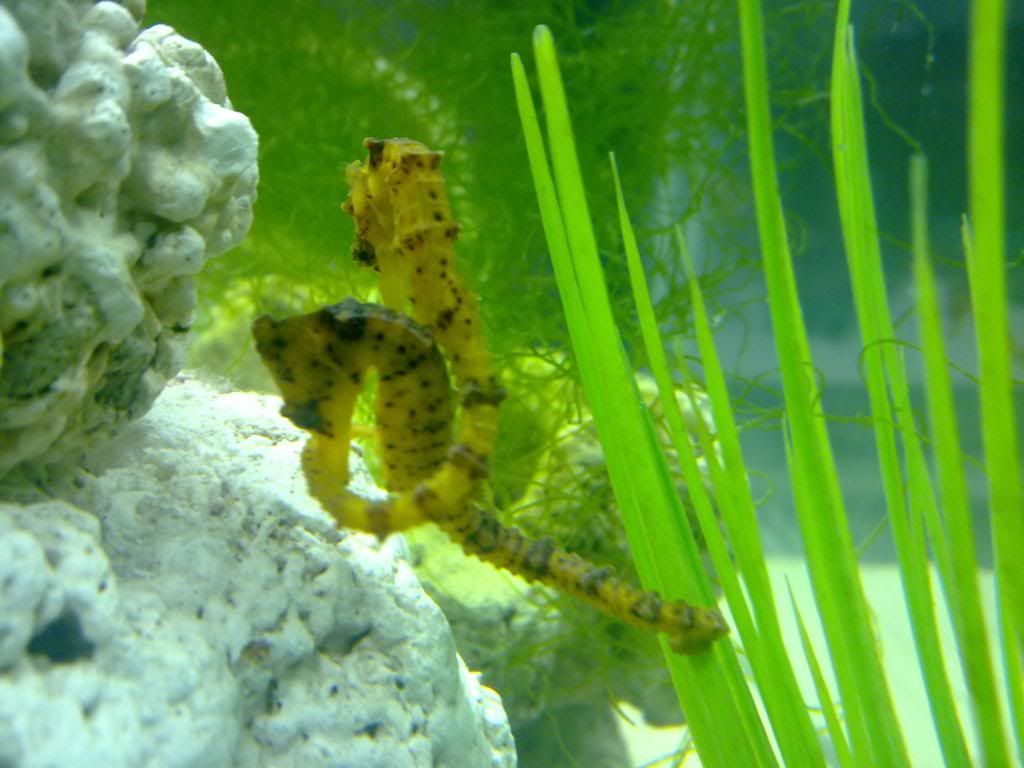
__________________
Alaukik "Experience is a wonderful thing. It enables you to recognize a mistake when you make it again." Current Tank Info: 300 gal reef tank & 30 gal seahorse tank |
|
|

|
|
|
#2 |
|
Registered Member
Join Date: Sep 2010
Location: India
Posts: 52
|
also, there is one horse who is a little bit reddish. like red spots all over body.
If I didnt kno any better, I would think that this horse is a bit sick. can someone help me clear my suspision. Its the only horse different from the others. 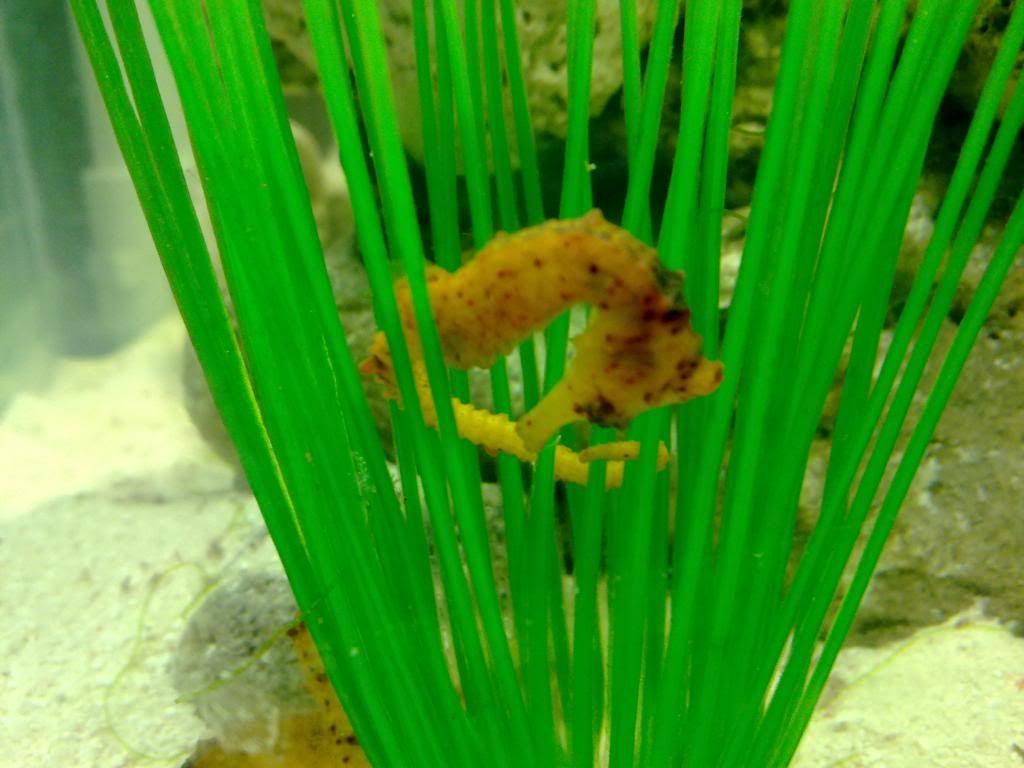 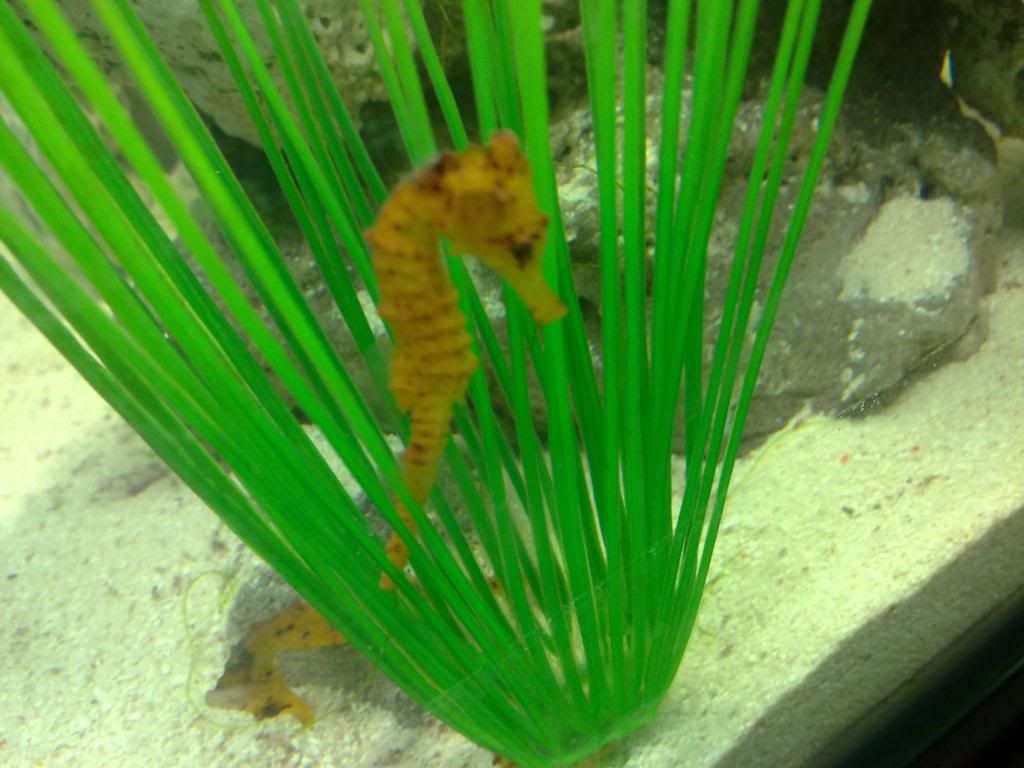 
__________________
Alaukik "Experience is a wonderful thing. It enables you to recognize a mistake when you make it again." Current Tank Info: 300 gal reef tank & 30 gal seahorse tank |
|
|

|
|
|
#3 |
|
Registered Member
Join Date: Jun 2004
Location: Ft. Pierce, FL
Posts: 698
|
The seahorses in the pics are H. reidi commonly known as the Brazilians. Looking at the bodies and the head to body ratio looks like they have not been fed enough. This usually stunts their growth with juveniles.
Normally we recommend at least a 30 gallon tank for a pair and a minimum of 15 gallons thereafter for each additional pair. Healthy specimens should be able to consume 1/2 to 1 cube of frozen mysis per pair per feeding at 2 to 3 times a day. That is a lot of organics going into a small tank. Short term you should be fine. The biological filter may keep up with the ammonia but I doubt you have enough filtration to keep the organics from building up and you will eventually run into problems. The orange spots are normal. Seahorses can change colors and patterns, they are not fixed. Same species can look strikingly different. Dan |
|
|

|
|
|
#4 |
|
Registered Member
Join Date: Nov 2013
Posts: 45
|
Wow! Beautiful horses. Did your friend breed them..?? You're going to have to figure out a better situation with larger tanks for them, or start selling/giving away some because they do have a large bioload for that size tank. I would buy a pair. :P
Have you tried feeding them? Have they been eating well? That's the first priority, to make sure they're eating. Ask your friend if he was feeding frozen or live. |
|
|

|
|
|
#5 | |
|
Registered Member
Join Date: Sep 2010
Location: India
Posts: 52
|
Quote:
Wow!! Looks like I have been widely misinformed. based on what you are recommending, I think they are underfed. all combined dont finish more than 2 cubes of frozen mysis/day. I also feed them freshly hatched brine shrimp everyday, but I dont think that is also consumed fully. I have been adding copepods (from my reef tank) in cheto for 2-3 days. I was hoping they will breed enuf to provide an alt food source for seahorses. On filteration part. I have a nano skimmer and a 200 micron filteration sock in the sump. But if one pair requires 30g I'll have to change the setup soon. my ponies are about 2 inches in height averagely. I thought that they were juvenilles. what is the recommended food and QTY for this size?
__________________
Alaukik "Experience is a wonderful thing. It enables you to recognize a mistake when you make it again." Current Tank Info: 300 gal reef tank & 30 gal seahorse tank Last edited by Alaukik; 02/15/2014 at 07:38 PM. |
|
|
|

|
|
|
#6 | |
|
Registered Member
Join Date: Sep 2010
Location: India
Posts: 52
|
Quote:
but atleast I am relieved that the red spots are not an outward sign of disease.
__________________
Alaukik "Experience is a wonderful thing. It enables you to recognize a mistake when you make it again." Current Tank Info: 300 gal reef tank & 30 gal seahorse tank Last edited by Alaukik; 02/15/2014 at 07:42 PM. |
|
|
|

|
|
|
#7 | |
|
Registered Member
Join Date: Sep 2010
Location: India
Posts: 52
|
Quote:
I highly doubt that these are tank bred. he got these from Indonesia. I have been trying various things - frozen mysis, artemia & copepods, but based on Dans' recommendation, I think they are underfed. They take sooooo long time to eat one nibble of food. I have to monitor them atleast for 1/2 an hour after feeding. I would gladly give away some.. But i am located in India & will take atleast 30-60 hours to ship outside. plus an IDed pony would be much easier to take care of.
__________________
Alaukik "Experience is a wonderful thing. It enables you to recognize a mistake when you make it again." Current Tank Info: 300 gal reef tank & 30 gal seahorse tank Last edited by Alaukik; 02/15/2014 at 07:41 PM. |
|
|
|

|
|
|
#8 |
|
Registered Member
Join Date: Jun 2004
Location: Ft. Pierce, FL
Posts: 698
|
There are some breeders in Indonesia, so I would not be surprised if they are breeding this species. This species is also bred in Sri Lanka.
2 inches is small. We don't normally sell them until they reach the 3 1/2 to 4 inch range. Given the size, they may not eat as much yet and if they are stunted, they won't eat as much anyway. Copepods are good but too small of a food item for them at this size. Just too small of a mass. They need larger food items to fatten up and start growth. Same with the freshly hatched brine. They should be eating adult brine and frozen mysis at this size. If accessible, I would also give them small live shrimp. Dan |
|
|

|
|
|
#9 | |
|
Registered Member
Join Date: Sep 2010
Location: India
Posts: 52
|
Quote:
can you be specific which kind of live shrimp will serve the purpose? (other than mysis. We have only frozen mysis available here.
__________________
Alaukik "Experience is a wonderful thing. It enables you to recognize a mistake when you make it again." Current Tank Info: 300 gal reef tank & 30 gal seahorse tank |
|
|
|

|
|
|
#10 |
|
Registered Member
Join Date: Sep 2010
Location: India
Posts: 52
|
Made a makeshift brine shrimp tank. It should work for atleast 4 weeks.
Is spirulina the only thing you can feed brine shrimp? (ordered powdered spirulina). or can you feed them freeze dried cycplopzee and daphnia to increase the nutritional content of the shrimp? the procedure online said we can feed wheat, egg yolk or yeast. But does it increase nutritional value? below are some pics of my brine shrimp tank & arrangement. 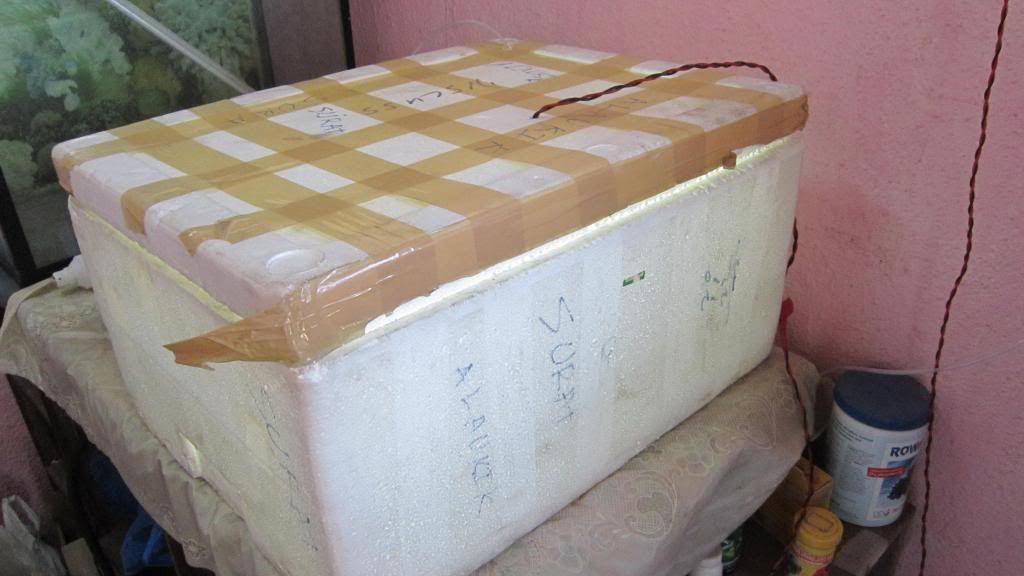 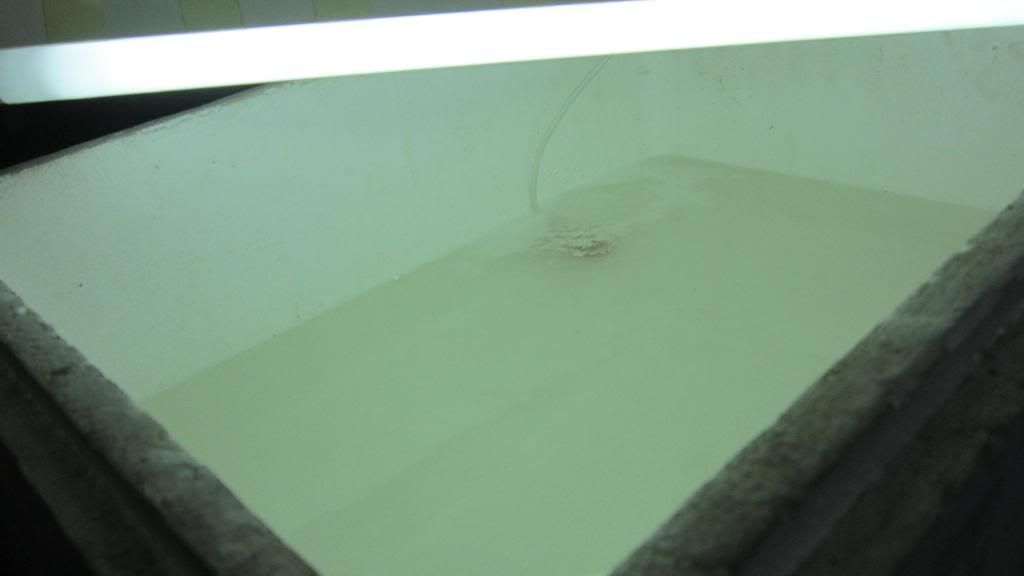
__________________
Alaukik "Experience is a wonderful thing. It enables you to recognize a mistake when you make it again." Current Tank Info: 300 gal reef tank & 30 gal seahorse tank |
|
|

|
|
|
#11 |
|
Registered Member
Join Date: Jun 2004
Location: Ft. Pierce, FL
Posts: 698
|
Adult brine shrimp can certainly work. The spirulina, egg yolk, yeast, etc. is good for feeding the brine but you will want to try to find an enrichment such Selco or AlgaMac for enriching them prior to feeding them out to the seahorses. The cyclopeez and daphnia won't work, much too large for the brine. Brine are filter feeders. The ideal size of the food in the water should be around 7 to 8 microns in size. They will consume slightly larger particles up to around 16 microns or so but should consume most of the 7 to 8 micron particles first. The enrichment needs to be high in HUFA's, especially DHA as artemia rapidly catabolize DHA to EPA. The enrichment food should be added to whatever you are going to feed out 2 to 4 hours before feeding out.
As for the other shrimp. Live mysids are ideal but any small shrimp that are available will suffice. Dan |
|
|

|
|
|
#12 |
|
Registered Member
Join Date: Oct 1999
Location: London, Ontario, Canada
Posts: 3,969
|
Based on my almost 20 years of growing brine shrimp to adult, the Styrofoam container is going to cause you problems in your endevour.
The bacteria can wipe out a culture in no time at all, and it will be difficult to properly clean the inside of that container. You may be able to adapt some of my methods to your situation but mine are done on an intensive density, large volume basis. Raising Brine Shrimp to Adult
__________________
Seahorses. Culture nanno, rotifers and brine shrimp. Current Tank Info: Seahorses |
|
|

|
|
|
#13 |
|
Registered Member
Join Date: Oct 1999
Location: London, Ontario, Canada
Posts: 3,969
|
I just realized you have Rowaphos, seen in the exterior picture of the Styrofoam container.
I used this once on one of my seahorse tanks and ended up loosing the seahorses. I never knew what happened until some time later, the topic came up on seahorse.org about iron based phosphate removers. It turns out that there are two different types of iron based phosphate removers with one being problematic to the seahorses and the other being OK. Chemipure Elite and Rowaphos are both seen as bad for seahorses, while the regular Chemipure is a different format of iron and works OK. Just from memory I think the bad form causes gill problems.
__________________
Seahorses. Culture nanno, rotifers and brine shrimp. Current Tank Info: Seahorses |
|
|

|
|
|
#14 | |
|
Registered Member
Join Date: Sep 2010
Location: India
Posts: 52
|
Quote:
this tank feels very weird. I am used to my bigger tank, where flow is in 1000s of gal/h and water change means a full container of water and this tank is doing less than 250 gal/hr. Well that's seahorse tank for you. I tried importing Selco, But they dont send liquid stuff over. Something to do with courier policies. I'll look into some live shrimps. Live mysid is not available. we have some live blood worms available. can they work? I have to keep them eating for next 3 weeks, till my brine shrimps are ready.
__________________
Alaukik "Experience is a wonderful thing. It enables you to recognize a mistake when you make it again." Current Tank Info: 300 gal reef tank & 30 gal seahorse tank |
|
|
|

|
|
|
#15 | ||
|
Registered Member
Join Date: Sep 2010
Location: India
Posts: 52
|
Quote:
Wow!! thats a great article. Just out of curiosuty, I want to understand how styrofoam is more susceptible to bacterial infection than polyethene bag/bucket? I am afraid if I crash this system, i'll be out of produce at end of three weeks. Tommorow I am going to start another system in 5gal bucket. Quote:
If u dont mind, can u elaborate on Vit premix & beta carotene? Others I can arrange. I donno much abt the above two. In any case it going to be tough 3 weeks for me and my ponies.
__________________
Alaukik "Experience is a wonderful thing. It enables you to recognize a mistake when you make it again." Current Tank Info: 300 gal reef tank & 30 gal seahorse tank |
||
|
|

|
|
|
#16 | |
|
Registered Member
Join Date: Sep 2010
Location: India
Posts: 52
|
Quote:
Sorry for the bad foto. I have accumulated quite some things over past years. Rowaphos is meant for my 300 gal tank only. But thats a valuable input. I might have made a grave mistake in my seahorse tank.
__________________
Alaukik "Experience is a wonderful thing. It enables you to recognize a mistake when you make it again." Current Tank Info: 300 gal reef tank & 30 gal seahorse tank |
|
|
|

|
|
|
#17 |
|
Registered Member
Join Date: Oct 1999
Location: London, Ontario, Canada
Posts: 3,969
|
There are a few different Vitamin premix recommendations but most people don't have access to make up the supplies to make them. see Vitamin (and Mineral) Mix No. 1 (Warm-Water Fish) shown after the various mineral mixes.
It doesn't have to be exact. Here in Canada we have a company called Angelfins that sells premixes. see Spawn and Grow so you could try places like http://www.indiamart.com/servetfeedsandminerals/aquaculture-feed-supplement.html to see if they have an aquatic vitamin premix. There may also be other companies you could access if you search. If you find one, some premixes also include the beta carotene. I only made my own DIY once and I got my beta carotene from a health food store. The Styrofoam container has a certain porosity that makes it difficult to clean properly. If you have a leakproof polyethylene bag you could use it as a liner. Time to get the brine to adult size will vary with many conditions which include temperature, culture density, frequency of feeding, husbandry, and, to some extent, luck. You can get a very low density culture to adult a lot faster than a high density culture. Rectangular containers aren't the best for growing as they are difficult to keep the food in suspension. Tapered cones work best but as they are too expensive that led me to using inverted 5g water bottles where I could put the open ended air line tube down into the neck of the bottle. My 26g garbage pail containers are also not the best, but I have them propped on an angle so that the air line is at the lowest point and does better than just having the container sit flat on the shelf. While you don't have live mysid available, you can use live mysis or ghost shrimp or cherry shrimp which are fresh water types but live long enough in the salt water to use for feed. They are much better if enriched first, same as live brine shrimp.
__________________
Seahorses. Culture nanno, rotifers and brine shrimp. Current Tank Info: Seahorses |
|
|

|
|
|
#18 | ||||
|
Registered Member
Join Date: Sep 2010
Location: India
Posts: 52
|
Quote:
Meanwhile, I have written to Aquafin, lets hope they ship it to India. Its in the category of dry goods, so it should not be a problem in shipping (unless of course company itself dosent ship). Quote:
Quote:
So now its just husbundary, word from the experts and beginers luck.  Quote:
__________________
Alaukik "Experience is a wonderful thing. It enables you to recognize a mistake when you make it again." Current Tank Info: 300 gal reef tank & 30 gal seahorse tank |
||||
|
|

|
|
|
#19 |
|
Registered Member
Join Date: Oct 1999
Location: London, Ontario, Canada
Posts: 3,969
|
It's not the mineral mix you want, but the vitamin premix.
Shipping costs would be atrocious from Canada to India. Are you keeping the egg yolk sealed and refrigerated? Actually, the egg yolk is doing two things. It is a food, and it is an emulsifier of the liquid enrichment ingredients. Brine shrimp are known as filter feeders. However, they DO NOT take in fluids other than what is soaked into or is coating food particles that they ingest. They DO NOT pass water through their systems like say a clam does to remove nutrients. Instead, they capture food particles with their appendages and pass the particles to the mouth for digestion. By emulsifying liquid nutrients/vitamins/medications, you make particles that can be captured and ingested by the brine shrimp. While commercial products like selco and selcon use special chemicals for doing this emulsion, DIY forms many times use the egg yolk only. I have had differing experiences than Dan has with particle sizes in that I've found they will not hesitate to capture and eat particle sizes in the 30 to 40 micron range. The Artemia Reference Centre at the University of Ghent says only that particle sizes should be not greater than 50 but preferably less.
__________________
Seahorses. Culture nanno, rotifers and brine shrimp. Current Tank Info: Seahorses |
|
|

|
|
|
#20 |
|
Registered Member
Join Date: Oct 1999
Location: London, Ontario, Canada
Posts: 3,969
|
Forgot to mention, if they are readily taking the frozen mysis then they probably only need more feedings per day for the next month or so to fatten them up. Live foods are NOT an absolute necessity.
Part of the husbandry would be to remove any uneaten foods before they begin to decay. Check especially around and behind rock and decor. With the numbers of seahorses you have in that tank, I'd be doing large water changes VERY frequently.
__________________
Seahorses. Culture nanno, rotifers and brine shrimp. Current Tank Info: Seahorses |
|
|

|
|
|
#21 | ||
|
Registered Member
Join Date: Sep 2010
Location: India
Posts: 52
|
Quote:
 they are not shipping to India. Man!! they are not shipping to India. Man!!I woudnt have cared much if it helped my horses. Mostly we are paying double for most imported items (shipping is always as much as the product). Quote:
or can the alternatives like multivitamin tablet or Kent marine Vit C type can work? also what is the function of beta carotene? Now I understood the work of yolk. Egg yolk was not stored. I broke an egg and fed it fresh only.
__________________
Alaukik "Experience is a wonderful thing. It enables you to recognize a mistake when you make it again." Current Tank Info: 300 gal reef tank & 30 gal seahorse tank |
||
|
|

|
|
|
#22 | ||
|
Registered Member
Join Date: Sep 2010
Location: India
Posts: 52
|
Quote:
Quote:
I would love to understand how seahorse tanks are cleaned. I am now seriously considering a bare-bottom tank (unless they start accepting food from a tray).
__________________
Alaukik "Experience is a wonderful thing. It enables you to recognize a mistake when you make it again." Current Tank Info: 300 gal reef tank & 30 gal seahorse tank |
||
|
|

|
|
|
#23 | |
|
Registered Member
Join Date: Sep 2010
Location: India
Posts: 52
|
Quote:
__________________
Alaukik "Experience is a wonderful thing. It enables you to recognize a mistake when you make it again." Current Tank Info: 300 gal reef tank & 30 gal seahorse tank |
|
|
|

|
|
|
#24 |
|
Registered Member
Join Date: Oct 1999
Location: London, Ontario, Canada
Posts: 3,969
|
You don't have to have very low flow for seahorse tanks. Most of us would have flow rates in the 10 to 20 times tank volume.
What is important is to have protection so intakes cannot trap seahorses, and to have no flow that can dash seahorses against rocks, sides, decor, to do them damage. You have an especially demanding situation as your tank is REALLY overloaded, and this makes probability of bacteria infestations that may lead to seahorse deaths, much more risky. I've had H. reidi densities of 24 in a 65g tank but the tank was bare bottomed and I did daily vacuuming/cleaning with minimum 10g water change daily as I did the husbandry. Like Dan, the pictures you show appear to be H. reidi and they are more likely IME to get to the 5 to 6 inch range. I don't use feeding dishes in any of my tanks because I found some use it and some don't, so I broadcast feed into the flow of water and try to keep it in suspension as long as possible. Then I have a timer than turns on a filter about 45 minutes later to help remove any particles still in the water column. Any particles that fall to the bottom, I vacuum out once every day or two. I don't want the seahorses to feed off the bottom as some food particles on the bottom may be nasty bacteria laden if they've been on the bottom for very long. All my mechanical filters get cleaned very frequently so as not to provide a foothold for nasty bacteria to culture. Dirtier tanks every other day and tanks with fewer seahorses may be 5 to 7 days. Baby brine is virtually of no value to them because the size means you would have to have an inordinate amount to provide any nutrition at all. Also, they don't provide the DHA component when not enriched properly. I had only made up one batch of the DIY enrichment as it was a PITA for me. I used vitamin premix in it. Some vitamins, like vitamin C need to be stabilized so you can't just use any specific product we would use. The beta carotene I think is used to bring out the colours better but I don't know that for a fact. When I feed the frozen mysis shrimp I add what appears to be about 40 to 50 pieces for each of the seahorses in the tank, as they will not normally eat every piece provided, preferring to only eat pieces that look "perfect" in their eyes, leaving the rest to become bacteria beds. For me, I prefer more frequent feedings with less quantity than to have fewer heavy feedings. When I clean my tanks, I use a mag float glass cleaner to scrub down the tank sides of algae/bacteria film, and as I have bare bottom tanks, after I vacuum the debris out, I use a home made cleaner with a handle to scrub the tank bottom. http://www.angelfire.com/ab/rayjay/swivel.html I make sure to move all rockwork and hitching/decor to get all the trapped particles out, even to removing some of the decor and rinsing off the trapped food particles when needed.
__________________
Seahorses. Culture nanno, rotifers and brine shrimp. Current Tank Info: Seahorses |
|
|

|
|
|
#25 |
|
Registered Member
Join Date: Sep 2010
Location: India
Posts: 52
|
wow! thats quite a procedure.
For me, salt cost itself will be insurmountable. I think that a semi dialysis kind of a system would be gr8. where you suck out all the leftovers and clean the tank like a normal water change procedure, but we dont throw away the siphoned water, instead we skim and filter the water and put it back after couple of days. technically water "goes bad" after the decay. the price of water and salt would definately surpass the cost of a good skimmer. Personally, I made only three water changes in my reef tank(averagely of 30gal) last year. I only have a problem of phosphates, which is due to over feeding on my part. so I think that this could work. what do you guys think?
__________________
Alaukik "Experience is a wonderful thing. It enables you to recognize a mistake when you make it again." Current Tank Info: 300 gal reef tank & 30 gal seahorse tank Last edited by Alaukik; 02/20/2014 at 04:21 PM. |
|
|

|
 |
| Tags |
| disease check, identification, seahorse |
|
|